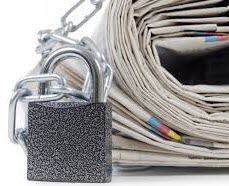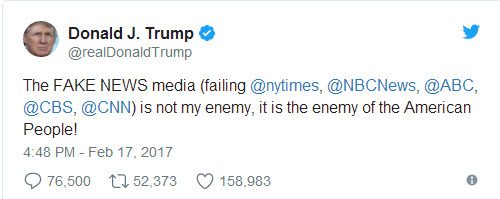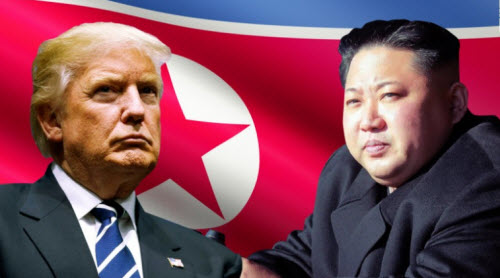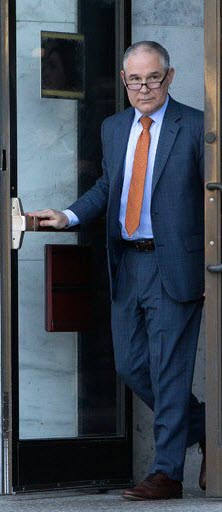Donald Trump’s Problem With the First Amendment
Donald Trump’s mission is to destroy America’s confidence in a free press and replace it with his own fabulist imaginings. He works to erode the credibility of
our core democratic institutions. Our criminal justice system is “a joke”, and “a laughing stock”. Our electoral system was “rigged” when it seemed he would lose, and we will hear that again this year if Democrats gain. He uses the language of Joseph Stalin to call the media “the enemy of the people”. Journalists are “very smart, they’re very cunning and they’re very dishonest”. His invective toward them is unending. “I gotta tell you, the media is [sic] among the most dishonest groups of people I’ve ever met”.
John McCain said that attacking the legitimacy of the press is “how dictators get started”. So say two Harvard professors in a new book, “How Democracies Die”. In their global analysis of deteriorating democracies, Steven Levitsky’s and Daniel Ziblatt’s say that attacks on the media are part of the autocrat’s instruction manual.
“Fake. One of the greatest terms of all I’ve come up with”, Trump said to Mike Huckabee of the adjective he uses constantly to delegitimize the media categorically. Incredibly, it works. As far back as January, Lamar Smith, a Republican representative from Texas said,
“Better to get your news directly from the president. In fact, it might be the only way to get the unvarnished truth”.
Trump’s base, of course, cheers him on. They may not be persuaded that Hillary Clinton won the popular vote because 3 million illegals voted for her, nor that President Obama tapped his phones in Trump Tower, but for most of the 2,000-plus falsehoods or misleading claims he has uttered since he took office, his followers most likely know no better. They don’t read the extraordinary fight the major arms of the media are waging to refute Trump’s lies and post the truth.
Consider the newspaper, in print or Internet. It teems every day with information. Paging through a print edition gets that point across more clearly than the drill down layers of online. There before you every morning is the world for you to browse with your orange juice and coffee. Going along with Trump’s blanket claim that all of it is fake news — believing that editors and writers dream up torrents of falsehoods every day — tells us how dimwitted his Americans are for believing such nonsense. Just listen to the roar of the crowd when the demagogue says “FAKE NEWS!”
The major media no longer follow the creed of objectivity. The better outlets have not so much allowed bias to creep into their news columns as they have commingled opinionated articles alongside straight news by labeling “analysis” or such. Or they show bias in their selection of what they cover or what is featured and what is buried. They have to. It’s what readers and viewers want, and the straitened times for the news media means they must attend to reader preferences. But bias is not the same as false, and the media has been doing extraordinary work during the Trump years in ferreting out the truth to counter the lies, the corruption, the cover-ups.
That’s not to Trump’s liking. Truth is his enemy. “As you know I have a running war with the media”. At a podium in December, pointing: “You see? That’s the fake news back there. Fake news”. To Mike Huckabee in October, “Look, the media’s fake. We’re doing so well in so many ways and nobody talks about it”. Again pointing to reporters, “I like real news, not fake news. You’re fake news”. At a press conference,
“The press honestly is out of control. The level of dishonesty is out of control. The press — the public doesn’t believe you people anymore. Now, maybe I had something to do with that. I don’t know. But they don’t believe you”.
Journalists are “sick people” who he believes “don’t like our country”, he told a crowd in Phoenix. He assaults them all. 
contagion
This has reverberated around the world. Trump admires and envies despots such as Putin and Erdogan for having the power to shut down newspapers and jail journalists in their countries. With his “fake news” slander he has signaled that he is in league with them. McCain again:
“Trump continues his unrelenting attacks on the integrity of American journalists and news outlets. This has provided cover for repressive regimes to follow suit”.
There were 42 journalists killed last year doing their job; 262 were imprisoned; 21 of those were arrested on charges of false news. This is what Trump has spawned:
“You can forge anything these days. We are living in a fake news era” — Syria President Bashar al-Assad.
“But since you are a fake news outlet then I am not surprised that your articles are also fake” — Philippines President Rodrigo Duterte.
The media “spread lots of false versions, lots of lies. This is what we call ‘fake news’ today, isn’t it?” — Venezuela President Nicolas Maduro.
threats
Neither the president nor Jeff Sessions’ Justice Department has taken action against journalists. So far, that’s the opposite of Barack Obama’s record. The Obama administration brought more cases against leakers and reporters than all of the administrations that preceded it combined, often by using the draconian Espionage Act. We reported on that in “Obama v. the Press: A History Worse Than Nixon?”
But it’s only Mr. Trump’s first year. And there are more than hints of what might come. He told then-FBI Director James Comey that journalists who publish classified information should be jailed. That has never occurred. It is generally argued that the Espionage Act applies to leakers, not to publishers or journalists — so far.
The president’s personal attorney has sued Buzzfeed and four of its reporters over the release of the Christopher Steele dossier on Russian contacts with the complaint that Trump’s reputation was damaged.
Last summer, NBC reported that when shown a chart of the steady reduction of U.S. nuclear weapons, Trump said he wanted a 10-fold increase to match the huge arsenal of the Kennedy years. For making this known the president threatened to have the network’s broadcast license revoked (not knowing that it is the local stations that are licensed, not the network). “It is, frankly, disgusting the way the press is able to write whatever they want to write”. The right-wing covers for him. DailyCaller.com said the liberal media had lost its “sense of humor” because this obviously was just a “moment of gleeful hyperbole”.
Trump had his attorneys send a cease and desist letter to publisher Henry Holt demanding that it not publish Michael Wolff’s book, “Fite and Fury”, a rather foolishly naïve maneuver given that the Supreme Court called “prior restraint” unconstitutional as far back as 1931. The publisher’s answer was to release the book early.
criticism not allowed
Trump would prefer to write laws that suit him; he has several times spoken of changing the laws covering libel. Early in his campaign he said:
One of the things I’m going to do if I win is I’m going to open up our libel laws so when they write purposely negative and horrible and false articles, we can sue them and win lots of money…. So when The New York Times writes a hit piece which is a total disgrace or when The Washington Post…writes a hit piece, we can sue them and win money… We’re gonna open up those libel laws, folks, and we’re gonna have people sue you like you never got sued before.”
Fortunately, he can’t change libel laws. Libel is a state-level tort meaning that it is up to state legislatures to decide what is libel and for state courts to interpret. But in New York Times v. Sullivan the Supreme Court put a lid on how freely states can write and adjudicate their laws. That revered ruling set the threshold for libel of a public official as requiring “actual malice” and “knowing or reckless disregard for the truth”. Justice William Brennan wrote that there must be a
“profound national commitment to the principle that debate on public issues should be uninhibited, robust and wide-open”, debate that “may well include vehement, caustic and sometimes sharp attacks on government and public officials”.
Of course, with hard right Supreme Court appointments, the court might simply overturn the precedent.
Nevertheless, President Trump lets nothing go, and he has exhibited little respect for established laws (see “Will the Rule of Law Survive Donald Trump?“. He was at it again not 10 days ago: “Our current libel laws are a sham and a disgrace,” Trump said before a Cabinet meeting at the White House on Wednesday. “We’re going to take a strong look at our country’s libel laws.”
Of concern is whether Trump and Sessions will begin using the Espionage Act against journalists citing the catch-all “national security” label and then threaten reporters with jail time if they don’t reveal their sources. The leaks have been invaluable for revealing the inexplicable contacts with Russians by the Trump camp.

Trump has just issued his fake news awards. He had mostly chosen news outlets that had made mistakes. The fact checking operation at the Washington Post asked:
Does it really count if the news organization admits error? Everyone makes mistakes — and the point is not to play gotcha. News organizations operate in a competitive arena and mistakes are bound to be made. The key test is whether an error is acknowledged and corrected.
Their analysis:
At least seven of the 11 “Fake News” winners resulted in corrections. Of those, two reports prompted suspensions or resignations. Two of the “awards” were simply tweets that were quickly corrected. One was an opinion article in which the author later retracted his prediction. And the final award went to the Russia investigation, which is ongoing.
On the other hand, the Post has been tallying Trump’s lies and misleading statements since he took office. In his first 355 days the count nosed over the 2,000 mark; each instance can be retrieved here. Trump lies uncontrollably, never admits error, never apologies, yet faults the media.
Instead we have the alternate universe of Sarah Huckabee Sanders lecturing journalists about mistakes that were corrected:
“You cannot say that it’s an honest mistake when you’re purposefully putting out information that you know to be false, or when you’re taking information that hasn’t been validated, that hasn’t been offered any credibility, and that has been continually denied by a number of people, including people with direct knowledge of an instance.”
“Are you speaking about the president?” one reporter shot back, in view of Mr. Trump’s long history of inventing claims with no validation.
With Twitter, Trump was ingenious enough to hit upon the most up-to-date path to circumvent the media and talk directly to his 46.9 million followers, from which perch he can say, don’t believe any of them, believe only me. “It is a common thing in the authoritarian playbook to discredit the media so that they are the only source that can be trusted,” said Indira Lakshmanan, who holds the Newmark chair in journalism ethics at the Poynter Institute for Media Studies.
Levitsky and Daniel Ziblatt identify a short list of indicators of incipient autocracy, one of which being disregard for civil liberties and intolerance of the media. Save for Richard Nixon,” no major-party presidential candidate met even one of their criteria over the last century”, they say, “Donald Trump met them all”. The most important point they make is this:
“This is how we tend to think of democracies dying: at the hands of men with guns. …But there is another way to break a democracy. It is less dramatic but equally destructive. Democracy may die at the hands not of generals but elected leaders — presidents or prime ministers who subvert the very process that brought them to power…The tragic paradox of the electoral route to authoritarianism is that democracy’s assassins use the very institutions of democracy — gradually, subtlely, and even legally — to kill it.”
Jan 29 2018 | Posted in Media | Read More »


